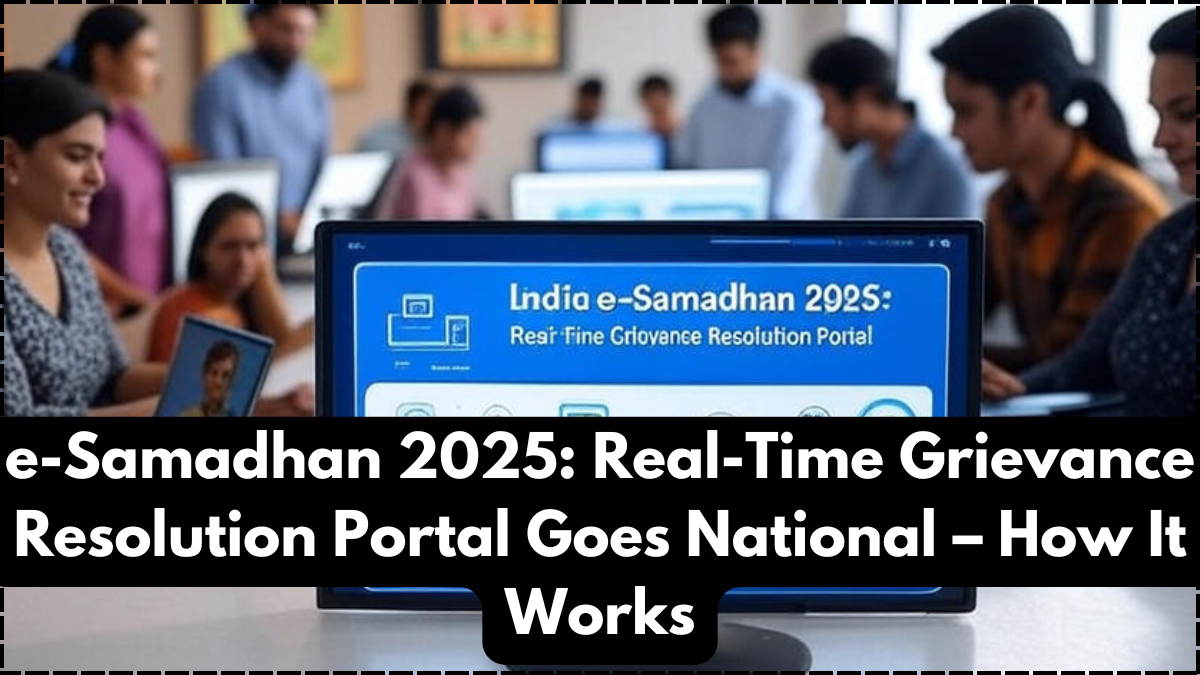In 2025, the government has officially launched the e‑Samadhan portal 2025 India as a fully fledged national grievance redress system govt, enabling citizens across the country to lodge, track, and resolve public service complaints in real time. Whether it’s a pending ration card, delayed pension, municipal issue, or public utility problem, the portal provides a single window access for grievance registration, status tracking, escalation, and feedback submission.
This platform consolidates various departmental grievance cells under one unified dashboard. With e‑Samadhan, citizens no longer need to navigate multiple offices or file separate complaints—they can submit one ticket that reaches the concerned department electronically and is tracked until resolution.

How the Portal Works
The e‑Samadhan portal 2025 India operates through a citizen‑centric workflow with defined service level agreements (SLAs) and escalation channels. Grievances can be submitted via mobile app, website, or via CSCs (Common Service Centres). Each application is assigned a unique tracking ID, and timelines are set based on issue category.
Here’s the grievance workflow:
Step |
Description |
Time Frame |
|---|---|---|
Registration |
Via app, portal, or CSC; citizen receives tracking ID |
Immediate |
Acknowledgement |
Auto‑confirmation and department allocation |
Within 24 hours |
Initial Resolution |
Department action and citizen update |
7–30 days depending on issue |
Escalation |
Automatic escalation to higher authority if no action |
48 hours past SLA |
Feedback & Closure |
Citizen can rate resolution and close ticket |
After resolution |
This systematic approach ensures protesters know exactly where their complaint stands at any time in the grievance redress system govt.
Coverage and Departments Supported
At launch, the e‑Samadhan portal 2025 India integrates with 15 central and state departments covering services such as:
-
Public distribution system (ration cards)
-
Pension schemes (social security, disability)
-
Utility services (water, electricity, sanitation)
-
Public works and local infra issues
-
Licensing and documentation (caste, domicile, birth/death certificates)
The portal also connects with national missions such as Ayushman Bharat, Jal Jeevan Mission, and education grievance cells like Samagra Shiksha. Expansion plans include tourism, environment, railways, and citizen petitions to lawmakers—all to be integrated by end‑2025.
With dashboards publicly accessible, citizens and CSOs (civil society orgs) can analyze grievance trends and demand localized action.
Benefits and Early Outcomes
The grievance redress system govt via e‑Samadhan dramatically improves accountability and transparency. Citizens no longer face repeated paperwork, unresponsive departments, or unclear timelines. Complaints are tracked, status is visible, and escalation paths are automated.
In pilot zones, more than 85% of submitted grievances were resolved within SLA timelines. Citizen satisfaction rose by 40%, and repeat complaints reduced by 30%. District administrations reported decreased manual foot traffic in grievance offices, freeing officials to focus on resolution rather than filing.
The feedback loop also lets departments measure performance, identify backlogs, and detect systemic issues—for instance, sanitation vs. electricity vs. pension delays.
How Citizens Can Use It
Using the portal is simple:
-
Register via mobile app or official e‑Samadhan portal—no login needed for initial filing.
-
Submit complaint by selecting grievance category, department, and district.
-
Upload any supporting documents (ID, application copies, etc.) or mark service center visit.
-
Track status in real time via tracking ID or mobile number.
-
If no response after SLA, system auto‑escalates to the next level.
Citizens can also submit feedback upon resolution, providing ratings and comments to close the ticket. Those without smartphones or internet can use CSC kiosks where operators assist them in lodging and tracking issues.
Challenges and Path Ahead
Some challenges remain—like local level department integration, awareness among rural populations, and language accessibility. To address this, the government is deploying language‑enabled voice bots, regional language support, and field outreach campaigns. Gram panchayats are being activated to promote awareness, and local CSOs are organizing digital empowerment drives.
Soon, biometric-based authentication may be added to verify complainants, and blockchain logging is under trial for auditability. A future roadmap includes integrating ML-based predictive routing to direct grievances to the best-performing officials, thereby reducing delays even further.
Conclusion
The e‑Samadhan portal 2025 India is a breakthrough in democratizing access to justice, public service, and governmental accountability. By consolidating grievance channels, enforcing SLAs, and providing layered escalations—even for remote villagers—this grievance redress system govt model brings transparency and efficacy to citizen services. With its tech backbone, data analytics, and inclusivity features, e‑Samadhan is redefining redressal as a citizen’s right, not a privilege.
FAQs
What is the e‑Samadhan portal 2025 India?
It is a national grievance redress system launched in 2025 to provide citizens with single‑window complaint registration, tracking, resolution, and feedback for public services.
How do I submit a grievance?
You can lodge a complaint via the web portal, mobile app, or through Common Service Centres by selecting the relevant department and service issue.
How long does it take to resolve a grievance?
Resolution timelines vary by category but range from 7 to 30 days. If no action is taken within the SLA, the issue is escalated automatically.
Who can use the system?
All Indian citizens can use it, including rural residents. CSC operators can assist those without internet or smartphone access.
Can I track the status after submission?
Yes. You receive a tracking ID and can monitor status updates via the portal, app, or CSC interface until the grievance is resolved and closed.
Click here to learn more